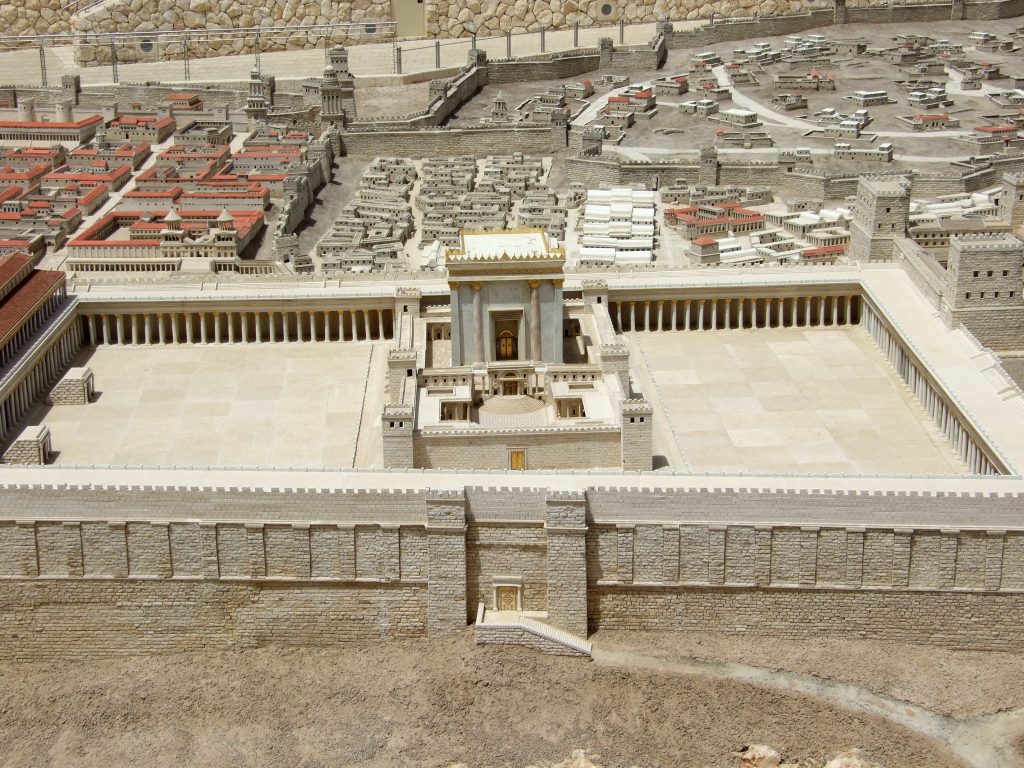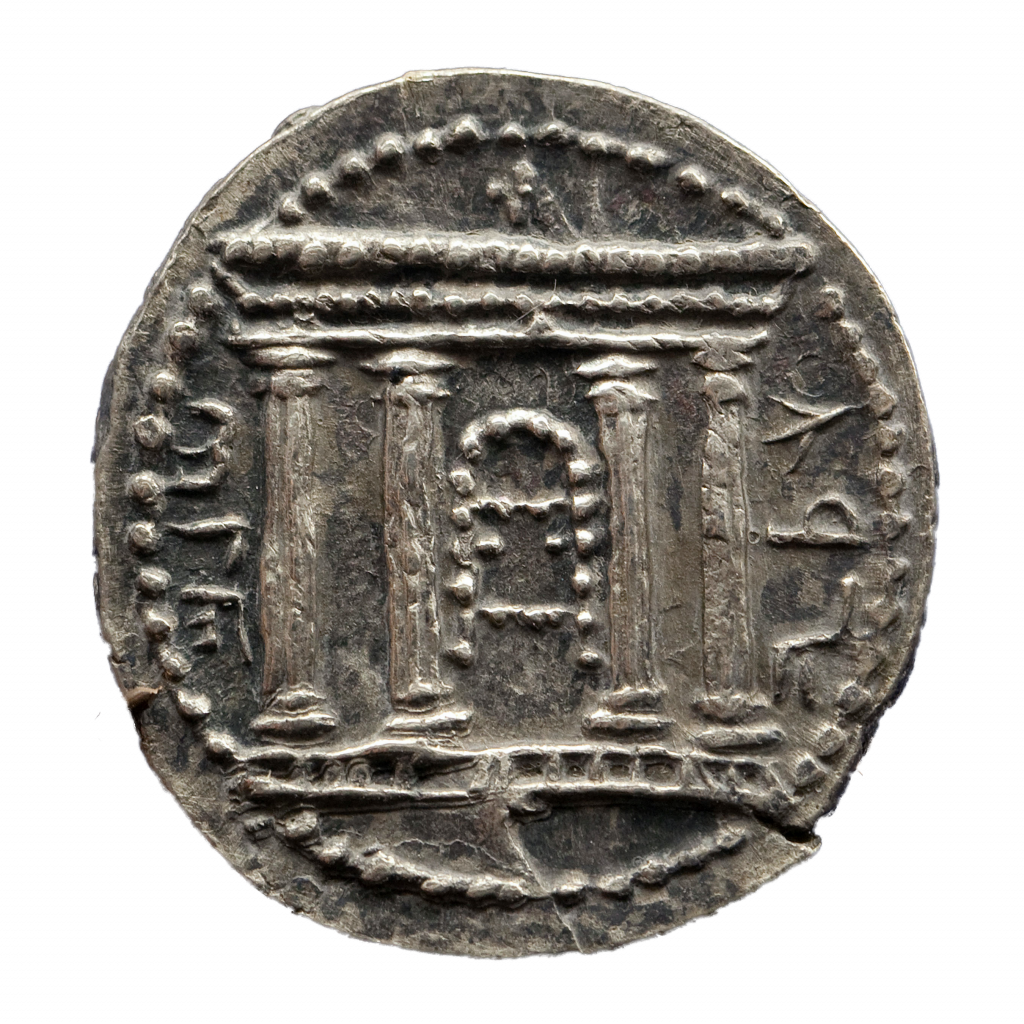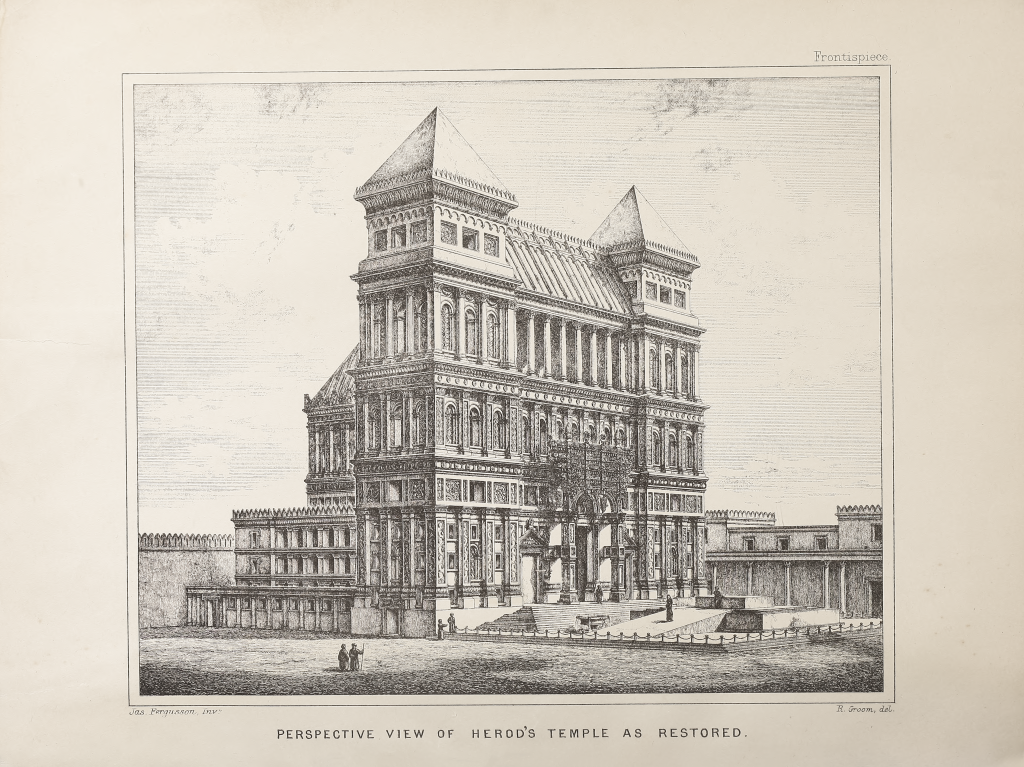
Dr. Michael Avi-Yonah’s model of Herod’s Temple. Photo: Copyright Israel Museum, Jerusalem/Holyland Tourism 1992, LTD
Everyone knows what the Beit Hamikdash looked like. Its picture is everywhere, plastered to flyers announcing Tishah B’Av programming and vividly brought to life in artwork imagining the final return to Zion.
But rarely do we stop to ask how we know what the Beit Hamikdash looked like. The building was destroyed by the Romans nearly 2,000 years ago. All that’s left today are portions of the Temple Mount’s outer retaining wall, most famously the Kotel. There were no photographs of course. So how can we know how the Mikdash looked, or for that matter, what it will look like when it’s rebuilt?
Nearly every representation of the Mikdash one sees today is based on the scale model of Herod’s Temple and the surrounding city created by historian and architect Dr. Michael Avi-Yonah for the Holyland Hotel in Jerusalem. Businessman Hans Kroch, who commissioned the model a few years before the Six-Day War in 1967—a time when Jews could not visit the Western Wall—is reported to have said, “If Jews cannot get to the holy places, the holy places will come to them.” Avi-Yonah’s model, completed in 1966, rapidly became an iconic representation, and in 2006, with the demolition of the Holyland Hotel, was moved to the Israel Museum, where it sits outside the Shrine of the Book housing the Dead Sea Scrolls and the rescued remains of the Aleppo Codex. It has become a nearly canonical image of the Mikdash that has influenced all subsequent models and popular drawings. Its features are readily recognizable, for example, in the model of the Beit Hamikdash by Michael Osanis that has graced the roof of Yeshivat Aish HaTorah next to the Kotel since 2009. The most astonishing and detailed contemporary model based on Avi-Yonah’s, however, might be the one a farmer and preacher named Alec Garrard worked on in his barn in Norfolk, England, for thirty years until he died in 2010.
Why did Avi-Yonah’s model come to dominate? Simply put, it came at the right time and was better researched and more faithful to the available sources than any previous model. Let’s explore those sources, as through them we can get an idea what the Mikdash might have looked like.
The first Beit Hamikdash is described in a couple of chapters in Sefer Melachim (1 Kings 6-7). But while the portrayal of Shlomo Hamelech’s construction includes evocative elements such as the yam shel shlomo—the metal basin atop twelve oxen—the description is not detailed enough for one to build a model like Avi-Yonah’s. And the Tanach contains virtually no description of Bayit Sheini built by Zerubavel and the returning Babylonian exiles. All we know is that it was not as impressive as the first. “Many of the priests and Levites and the chiefs of the clans, the old men who had seen the first house, wept loudly at the sight of the founding of this house,” Sefer Ezra (3:12) tells us. “For so much did that first temple which Solomon built exceed this [second] temple,” laments the Roman Jewish historian Flavius Josephus (c. 37-c. 100) (Antiquities 15:11:1).
But in 20 bce, King Herod (otherwise not the most celebrated Jewish leader), began a massive renovation project on the Second Temple that lasted at least until his death in 4 bce. The results were stunning. Chazal declare, “One who never saw [Herod’s] Temple when it stood, never saw a magnificent structure” (Sukkah 51b). Sadly, this structure lasted barely a lifetime; it was destroyed by the Romans in 70 ce. Nonetheless, it’s the most extensively documented iteration of the Mikdash, so it’s no surprise that it’s the one that people have chosen to model and depict.
An entire Mishnaic tractate, Masechet Middot, details the ins and outs of Herod’s Temple. Consider this quotation (Middot 2:5):
The courtyard of the women was a hundred and thirty-five cubits long by a hundred and thirty-five wide. It had four chambers in its four corners, each of which was forty cubits. They were not roofed . . . Fifteen steps led up from it to the courtyard of Israel, corresponding to the fifteen [songs of] ascents mentioned in the Book of Psalms, and upon which the Levites used to sing. They were not rectangular but circular like the half of a threshing floor.
These details and many more inform Avi-Yonah’s model. Another good example is the Mishnah’s description of the Mikdash’s Ulam, foyer or portico, being wider on each side than the Heichal—the structure housing the menorah, shulchan and other vessels. The mishnah (Middot 4:7) memorably describes the Ulam as reminiscent of a crouching lion, narrow behind and broad in front, and that’s how it appears in Avi-Yonah’s version.
Josephus is a critically important source too, having actually served as a kohen in Herod’s Temple before its destruction. He describes the structure in his Jewish War and in his Antiquities of the Jews. If you’re wondering, for example, about the spikes all around the top of the Heichal in Avi-Yonah’s model, they’re straight out of Josephus, who writes, “On its top it had spikes; with sharp points; to prevent any pollution of it by birds sitting upon it” (The Jewish War 5:5:6).
Yet, some important specifics are still missing. How was the roof of the Heichal shaped? From the Mishnah alone, one could plausibly depict the Mikdash with a sloped or gabled roof—like a typical house or even Greek temple. Some do depict it this way; I found a 1967 commentary to Masechet Middot with such pictures. But Avi-Yonah portrays the Heichal with a flat roof supported by four columns based on an ancient and nearly contemporaneous source. When Bar Kochba revolted against the Romans from 132 to 137 ce, less than seventy years after the Temple’s destruction, he and his supporters minted coins with symbols of their rebellion. One such coin features the façade of a flat-roofed four-columned Mikdash on its front, and the words “to the freedom of Jerusalem” on the back. A similar illustration of the Mikdash can be found among the wall murals of the Dura-Europos synagogue in Syria dated to the third century ce.

Coin from the period of the Bar Kochba Revolt (approx. 132 ce) featuring an image of the Beit Hamikdash. Photo: Eddie Gerald/Alamy Stock Photo
There have been countless artistic representations of the Beit Hamikdash in the nearly 2,000 years since its destruction. But they often look more like buildings from the artist’s time than an edifice that might plausibly have been constructed in ancient Jerusalem. In the nineteenth century, German architect Conrad Schick envisioned Herod’s Temple as a European castle, while the Scottish-born James Fergusson’s drawing has an Eastern flair, perhaps inspired by British colonial conquests. (His depiction of the Mishkan looks like a British army tent.) Thus, another advantage of Avi-Yonah’s model is that he tried to make the Mikdash look like other buildings of its time period. His model considered the design of other temples of its time, such as the Temple of Bel (or Baal) in Palmyra, Syria. It also looks akin to Me’arat Hamachpelah, the only Herodian structure still fully intact today.

Nineteenth-century illustrated conception by James Fergusson of what the Beit Hamikdash looked like. Artistic representations of the Mikdash often resemble buildings from the artist’s time. Courtesy of the Internet Archive
For all of its merits, the Holyland model remains an artist’s reconstruction. We cannot know exactly what the Mikdash looked like, and one could have reasonably made different choices than Avi-Yonah. Both the Mishnah and Josephus, for example, speak of a golden grapevine encircling the pillars that framed the doorway to the Heichal. The Mishnah says that whoever offered a grapevine to G-d used to hang it there (Middot 3:8). And according to Josephus, the entire front of the Ulam was “covered all over with plates of gold, of great weight: and at the first rising of the sun reflected back a very fiery splendor” (The Jewish War 5:5:6). Avi-Yonah did not include these features, possibly because no other Roman building is described as lavishly. Other architects, however, have disagreed. Contemporary architect and archaeologist Leen Rittmeyer’s model, held by Yeshiva University’s Museum in Manhattan, features both the golden frontispiece and the gold grapevine.
Still, it is Avi-Yonah’s Holyland model that has caught on, not Rittmeyer’s or any other. In addition to creating an excellent representation of the Mikdash, Avi-Yonah was in the right place at the right time. Completed on the verge of the Six-Day War and the retaking of the Temple Mount, the model came to symbolize Jewish pride. The model’s ubiquity means that I’ve often seen it anachronistically used to represent Zerubavel’s Bayit Sheini, and on occasion, I’ve even seen it standing in for the first Beit Hamikdash. These are mistakes, but understandable ones: Avi-Yonah’s tour-de-force of a model has become a tangible way to represent the entire concept of having a Beit Hamikdash, not just one particular version.
Interestingly, and as I noted at the outset, many also use Avi-Yonah’s model to portray the yet unbuilt Third Temple of the Messianic age. Some artists have drawn Avi-Yonah’s model descending from the heavens onto the Temple Mount. Indeed, Aish HaTorah’s roof model based on Avi-Yonah’s and just steps from the Kotel seems to beckon as follows: move me a few hundred feet, make me bigger, and we are ready for Mashiach. But this is somewhat curious: why do we assume that the rebuilt Temple will look just like Herod’s?
At first glance, using Herod’s Temple as a stand-in for the Third Beit Hamikdash seems to be just as mistaken as having it represent the First. Any representation of Bayit Shelishi ought to be based instead on the nine chapters at the end of Sefer Yechezkel that describe the Messianic edifice and the surrounding city in what appears to be great detail, complete with measurements. Surely, what Hashem showed Yechezkel looked quite different than Herod’s Temple. But on closer examination, it is not just modern artists who imagine the Third Temple looking like Herod’s; Chazal already conflate the two.
Throughout Masechet Middot, the Mishnah proves certain things about the appearance of Bayit Sheini by citing verses from Yechezkel. For example, I noted above that according to the Mishnah, there were four roofless courtyards in the Ezrat Nashim, one at each corner. The Mishnah quotes a verse in Yechezkel to support its assertion (Yechezkel 46:21-22). In some respects, at least, Chazal believed that the future Mikdash will be modeled on the prior one.
In truth, Yechezkel’s vision of Bayit Shelishi is quite difficult to understand. God takes Yechezkel on a whirlwind, disorganized tour of the Mikdash, whisking the prophet from one location to another without much explanation. As the Rambam notes, “The Temple which will be built in the future that is mentioned in Ezekiel is not described clearly or completely” (Mishneh Torah, Beit Habechirah 1:4). Rabbi Yom Tov Lipmann Heller (1578-1654), in the introduction to his commentary Tosafot Yom Tov to Masechet Middot, suggests that although the tractate ostensibly discusses the Second Temple, not the Third, its teachings are more than just a historical curiosity. Rather, the tractate merits inclusion in the Mishnah because we need its guidance for the future. “By recounting the Second Temple,” he writes, “we will be able to interpret and understand the structure of the building in Yechezkel. If this accounting were not written down, we would never be able to find our way regarding the future Beit Hamikdash.” In the view of the Tosafot Yom Tov, Herod’s construction is the key to unlocking the contours of the final Beit Hamikdash. Perhaps, then, it is not so farfetched to assume as the artists often do: when the Beit Hamikdash is rebuilt, it may look familiar.
May it come to pass speedily in our days.
For further reading:
– Simon Goldhill, The Temple of Jerusalem (Cambridge, Mass, 2005), 124-42.
– Maya Balakirsky Katz, “Avi-Yonah’s Model of Second Temple Jerusalem and the Development of Israeli Visual Culture,” in The Temple of Jerusalem: From Moses to the Messiah, Steven Fine, ed. (Leiden, 2011), 349-64.
– Peter J. Schertz and Steven Fine, “A Temple’s Golden Anniversary,” Biblical Archaeology Review, 42:1 (Jan./Feb. 2016), 50-61.
Yosef Lindell is a lawyer, writer, and lecturer living in Silver Spring, Maryland, with a masters in Jewish history from Yeshiva University. He is an editor of the Lehrhaus, and his articles have appeared there as well as in publications such as the Atlantic, the Forward, JTA, and Moment Magazine.